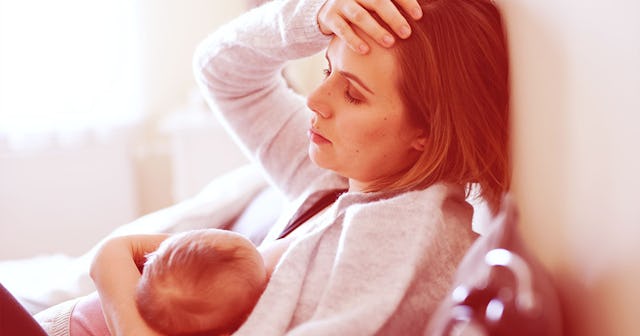Nipple Thrush From Breastfeeding Is A Thing — Here's What You Need To Know

Are your nipples burning and cracking? Are they shiny, itchy, and bleeding? Well, if they are — and if you’re breastfeeding –there’s a good chance you have nipple thrush, or a fungal infection of your breast tissue. And while many parents know the signs and symptoms of thrush in babies (it can cause white patches to appear on your infant’s tongue and cheeks, as well as fussiness, restlessness, and/or a diaper rash) the symptoms of non-oral thrush are not as well known.
Scratch that: Very few people talk about having a fungal infection on their breasts. But nipple thrush is common. Very common.
Here’s everything you need to know about nipple thrush, from a mama who’s been there.
What is thrush?
Thrush is an infection which commonly affects the mouth and/or mucous membranes of an infected individual. However, the Candida fungus — which causes thrush — can grow in other places, including on the skin.
How is it contracted?
While the Candida fungus causes thrush, the reason for its proliferation is unclear. Antibiotic usage, for example, may throw the body’s natural balance out of whack, giving the fungus both the room and ability to grow. Immunodeficiencies can cause thrush, as can smoking, diabetes, and the use of corticosteroids; however, healthy individuals also contract thrush.
Ever had vaginal itching? A whitish discharge? If so, you’ve probably had vaginal thrush, or a yeast infection. Yes, vaginal thrush, oral thrush, and nipple thrush are (essentially) the same thing.
How is thrush transmitted?
As for how thrush is transmitted, thrush isn’t contagious — at least not in the conventional sense. However, thrush can be passed from person to person, through close contact and/or kissing. What does this mean for breastfeeding parents? Well, it means that if your blessed bundle of joy contracts thrush, you’ll probably get the infection in or on your nipple.
What are the signs and symptoms of nipple thrush, i.e. what does it look and feel like?
While the signs and symptoms of nipple thrush vary from person to person, most individuals with this condition will experience pain. A lot of pain. But what does this pain feel like? Well, for me it was a pointed, sharp, shooting pain which radiated from my nipple to my breast and deep into my chest. (Trust me, Mama, it’s no joke.) My nipples were also extremely itchy and dry. They bled during every feeding.
Other signs of nipple thrush include:
- Itching
- Burning
- Redness
- Swelling
- Peeling skin, blisters, and/or “flaking”
How is nipple thrush treated?
I know, I know: All of this sounds like a blast, right? I mean, pain? Itching? Burning? Bleeding? Super cool. But fear not, there is hope. Thrush is treatable.
According to the Academy of Breastfeeding Medicine, nystatin is the first choice for treating thrush. Topical antifungals may also be used. In some cases, a gentian violet solution is applied, and oral antifungals may be given.
That said, it’s very important that you and your baby are treated at the same time. Why? Because yeast “is easily spread, and thrives in warm moist environments,” La Leche League explains. “Any skin that touches other skin is especially vulnerable.” Nipples, pacifiers, bottles, and breast pump parts should also be cleaned regularly and thoroughly.
“Anything that goes into your baby’s mouth (other than your breast or a finger) should be boiled for 20 minutes a day,” La Leche League adds. “Toys that go in your baby’s mouth should be washed with hot, soapy water.”
Can you continue breastfeeding with thrush?
The short answer is yes, you can breastfeed with thrush; however, it’s admittedly tricky. It is also uncomfortable as hell. (Sorry, but it’s the truth.) That said, if you want to continue breastfeeding while you and/or your little have thrush, consider the following:
- Ice your breasts prior to feedings. This will numb the area — and lessen the pain.
- Offer your baby shorter feedings, starting with your least painful breast.
- Take ibuprofen or another “safe” form of over-the-counter pain relief.
- Use nipple cream to treat the itching, cracking, and bleeding.
- Consider pumping.
- Note: This method will not work for everyone. I found pumping exponentially more painful. It also caused my nippples to bleed. A lot. But some find pumping to be a good alternative. Do what works best for you and your baby.
For more information about how you can treat and manage thrush or for additional tips and tricks regarding breastfeeding, visit the La Leche League website.
This article was originally published on